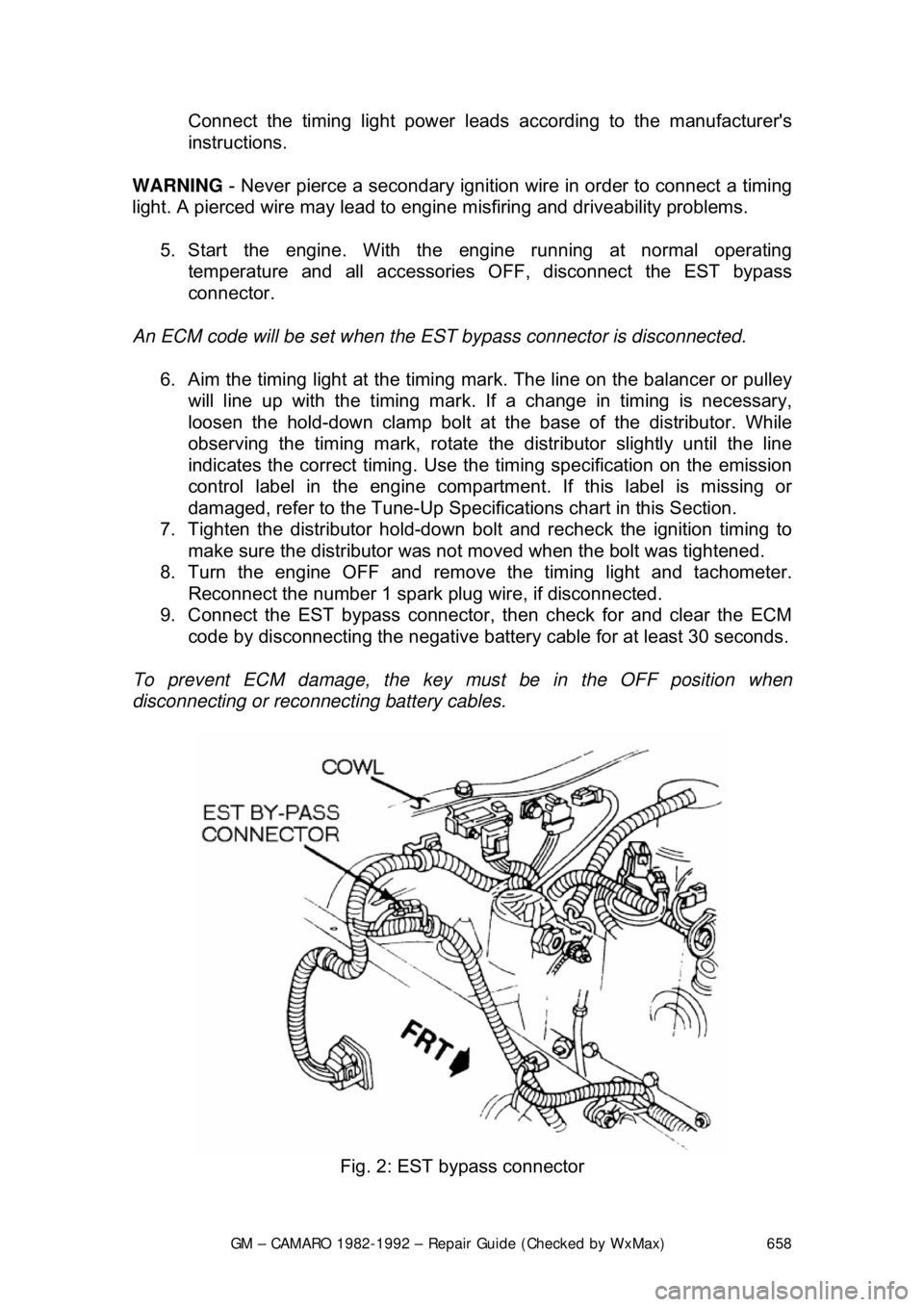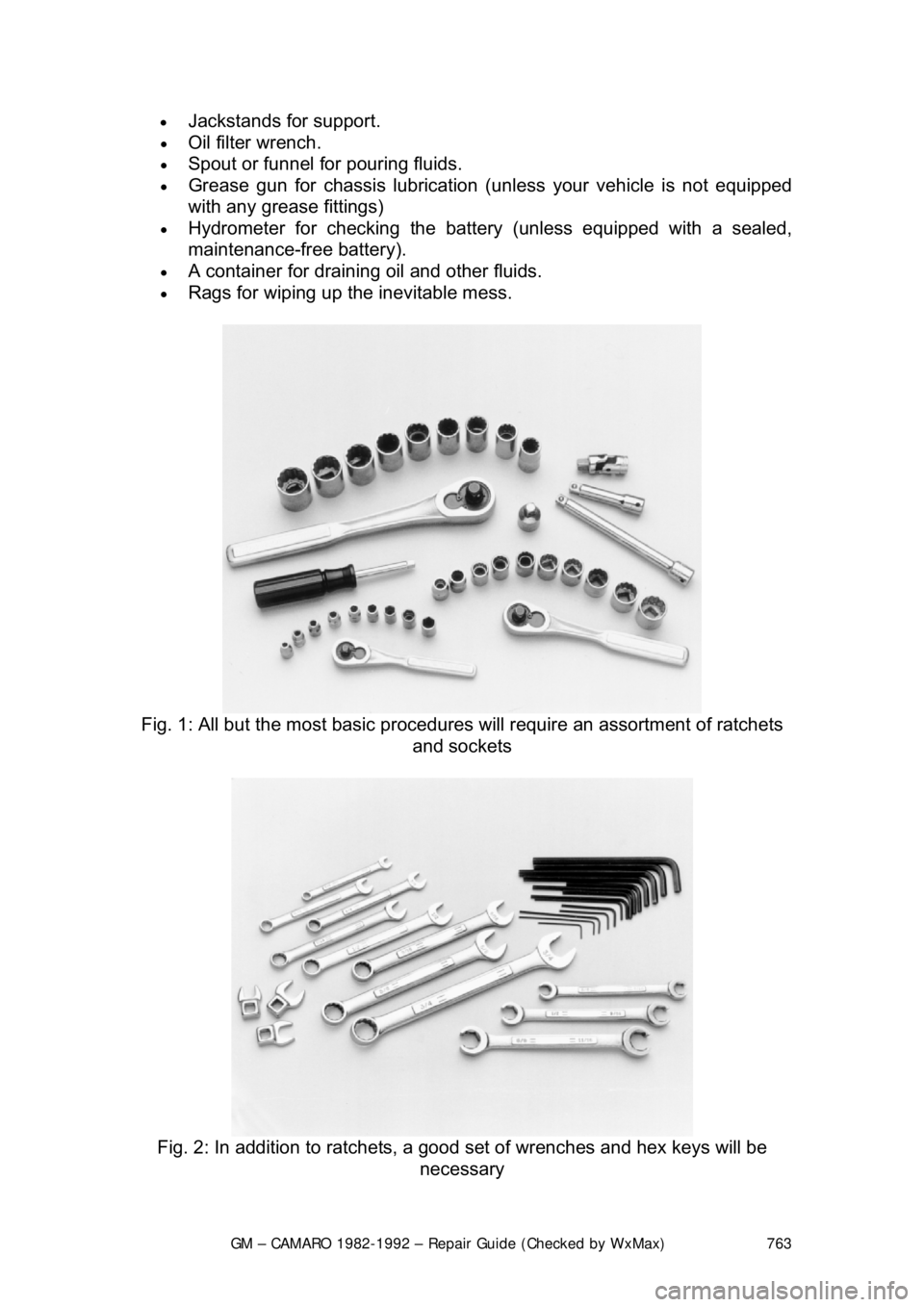1982 CHEVROLET CAMARO key battery
[x] Cancel search: key batteryPage 658 of 875

GM – CAMARO 1982-1992 – Repair Guide (Checked by WxMax) 658
Connect the timing light power leads
according to the manufacturer's
instructions.
WARNING - Never pierce a secondary ignition wire in order to connect a timing
light. A pierced wire may lead to engine misfiring and driveability problems.
5. Start the engine. With the engine running at normal operating
temperature and all accessories OFF, disconnect the EST bypass
connector.
An ECM code will be set when the EST bypass connector is disconnected.
6. Aim the timing light at the timing mark. The line on the balancer or pulley
will line up with the timing mark. If a change in timing is necessary,
loosen the hold-down clamp bolt at t he base of the distributor. While
observing the timing mark, rotate the distributor slightly until the line
indicates the correct timing. Use t he timing specification on the emission
control label in the engine compartm ent. If this label is missing or
damaged, refer to the Tune- Up Specifications chart in this Section.
7. Tighten the distributor hold-down bolt and recheck the ignition timing to
make sure the distributor was not moved when the bolt was tightened.
8. Turn the engine OFF and remove the timing light and tachometer.
Reconnect the number 1 spark plug wire, if disconnected.
9. Connect the EST bypass connector , then check for and clear the ECM
code by disconnecting the negative battery cable for at least 30 seconds.
To prevent ECM damage, the key must be in the OFF position when
disconnecting or reconnecting battery cables.
Fig. 2: EST bypass connector
Page 711 of 875

GM – CAMARO 1982-1992 – Repair Guide (Checked by WxMax) 711
THROTTLE BODY INJECTION SYSTEM
SYSTEM DESCRIPTION
The throttle body injection (TBI) system used on 2.5L (VIN 2) and 5.0L (VIN E)
engines is centrally located
on the intake manifold. Its function is to supply the
correct air/fuel mixture to the engine, as directed by the Engine Control Module
(ECM).
The TBI unit consists of two relatively simple casting assemblies: a throttle body
and a fuel metering assembly. Components include, a pressure regulator, idle
air control valve, fuel injector(s), thro ttle position sensor, fuel inlet and a fuel
return fitting.
The Throttle Body Injection identifi cation number is stamped on the lower
mounting flange located near the TPS. Th e number is in alphabetical code and
should be noted before servicing the unit.
An oxygen sensor in the exhaust syst em functions to provide feedback
information to the ECM as to oxygen content in the exhaust. The ECM then
uses this information to modify fuel de livery to achieve as near as possible an
ideal air/fuel ratio of 14.7 :1. This ratio permits the ca talytic converter to become
more effective in reducing emissions wh ile providing acceptable driveability.
Should you encounter any type of engine performance problem, have a
complete CCC system test performed by a qualified, professional technician. If
the fault lies in the injection system, you can use the following procedures to
remove the TBI unit and replace the defective component(s).
RELIEVING FUEL SYSTEM PRESSURE
1. Disconnect the negative battery cable to prevent fuel discharge if the key
is accidentally turned to the RUN position.
2. Loosen the fuel filler cap to relieve fuel tank pressure and do not tighten
until service has been completed.
3. Fuel system pressure is automatic ally relieved when the engine is turned
OFF. No further action is necessary.
When disconnecting fuel lines, there ma y still be a small amount of fuel
released. Cover the fuel line connection wi th a shop cloth to collect the fuel,
then place the cloth in an approved container.
ELECTRIC FUEL PUMP
REMOVAL & INSTALLATION
The fuel pump is part of t he fuel sender assembly located inside the fuel tank.
1. Release the fuel syst em pressure and disconnec t the negative battery
cable.
Page 726 of 875

GM – CAMARO 1982-1992 – Repair Guide (Checked by WxMax) 726
RELIEVING FUEL SYSTEM PRESSURE
1. Remove the fuse marked "Fuel Pu mp" from the fuse block in the
passenger compartment.
2. Crank the engine. Th e engine will start and run until the fuel supply
remaining in the lines is exhauste d. When the engines stops, engage the
starter again for three seconds to a ssure dissipation of any remaining
pressure.
3. With the ignition OFF, disconnect the negative battery cable to prevent
fuel discharge if the key is accidentally turned to the ON position.
Replace the fuse with the ignition OFF.
When disconnecting fuel lines, there ma y still be a small amount of fuel
released. Cover the fuel line connection wi th a shop cloth to collect the fuel,
then place the cloth in an approved container.
ELECTRIC FUEL PUMP
REMOVAL & INSTALLATION
The removal and installation procedures fo r the Crossfire injection system fuel
pump is identical to the Throttle Body In jection (TBI) system. Please refer to the
TBI fuel pump procedures earlier in this repair guide.
TESTING
The testing procedures for the Crossfire in jection system fuel pump is identical
to the Throttle Body Injection (TBI) syst em. Please refer to the TBI fuel pump
procedures earlier in this repair guide.
THROTTLE BODY
REMOVAL & INSTALLATION
FRONT UNIT
1. Relieve the fuel system pressure.
2. Remove the air cleaner assembly, noting the connection points of the
vacuum lines.
3. Detach the electrical connectors at the injector and the idle air control
motor.
4. Disconnect the vacuum lines from the TBI unit, noting the connection
points. During installation, refer to the underhood emission control
information decal for vacuum line routing information.
5. Disconnect the transmission det ent cable from the TBI unit.
6. Disconnect the fuel inlet (feed) and fuel balance line connections at the
front TBI unit.
7. Remove and discard the throttle cont rol rod retaining clip from the front
TBI throttle lever stud. A new clip must be used during reassembly.
8. Unbolt and remove the TBI unit.
Page 736 of 875

GM – CAMARO 1982-1992 – Repair Guide (Checked by WxMax) 736
The mass air flow systems measure the
mass of air that is drawn into the
engine cylinders, rather than just the vo lume. The sensor contains a hot-wire
sensing unit, which is made up of an electronic balanced bridge network.
Whenever current is suppli ed to the sensor, the bridge is energized and the
sensing hot-wire is heated. As the air enter s the mass air flow sensor, it passes
over and cools the hot wire. When the hot wire is cooled, it's resistance changes
and additional current is needed to k eep the bridge network balanced. This
increase in current is sent to the computer as a voltage signal and is used to
calculate the mass of the incoming air. The ECM uses this information to\
determine the duration of fuel injection pulse, ignition timing and EGR operation.
The speed density systems calculate the volume of air moving through the
intake. The ECM establishes the speed fact or through a signal from the ignition
module. The Manifold or Intake Air Temperature (MAT/IAT) and the Engine
Coolant Temperature (ECT) sensors work together to assure that proper
temperature information gets to the ECM wh ile the Manifold Absolute Pressure
(MAP) sensor monitors the changes in m anifold pressure which results from
changes in engine loading. These three se nsors contribute to the density factor.
Together, these inputs (engine speed, coolant temperature sensor, etc ...) are
the major determinants of the air/fuel mixture delivered by the fuel injection
system.
The following engines and fuel managem ent systems are covered in this
section:
• 1985-1989 2.8L MPFI - Mass Air Flow
• 1990-1992 3.1L MPFI - Speed Density
• 1985-1989 5.0L and 5.7L TPI - Mass Air Flow
• 1990-1992 5.0L and 5.7L TPI - Speed Density
Relieving Fuel System Pressure
1. Disconnect the negative battery cable to prevent fuel discharge if the key
is accidentally turned to the RUN position.
2. Loosen the fuel filler cap to reliev e the tank pressure and do not tighten
until service has been completed.
3. Connect J-34730-1 fuel pressure gauge or equivalent, to the fuel
pressure test valve. Wrap a shop towel around the fitting while
connecting the gauge to prevent spillage.
4. Place the end of the bleed hose into a suitable container and open the
valve to relieve the fuel system pressure.
ELECTRIC FUEL PUMP
REMOVAL & INSTALLATION
The fuel pump is part of t he fuel sender assembly located inside the fuel tank.
Page 763 of 875

GM – CAMARO 1982-1992 – Repair Guide (Checked by WxMax) 763
•
Jackstands for support.
• Oil filter wrench.
• Spout or funnel for pouring fluids.
• Grease gun for chassis lubrication (unl ess your vehicle is not equipped
with any grease fittings)
• Hydrometer for checking the battery (unless equipped with a sealed,
maintenance-free battery).
• A container for draining oil and other fluids.
• Rags for wiping up the inevitable mess.
Fig. 1: All but the most basic procedures will require an assortment of ratchets
and sockets
Fig. 2: In addition to ratchets, a good set of wrenches and hex keys will be
necessary
Page 771 of 875

GM – CAMARO 1982-1992 – Repair Guide (Checked by WxMax) 771
A more advanced set of tools, suit
able for tune-up work, can be drawn up
easily. While the tools are slightly more sophisticated, they need not be
outrageously expensive. There are severa l inexpensive tach/dwell meters on
the market that are every bit as good for the average mechanic as a
professional model. Just be sure that it goes to a least 1200-1500 rpm on the
tach scale and that it works on 4, 6 and 8-cylinder engines. The key to these
purchases is to make them with an eye towards adaptability and wide range. A
basic list of tune-up tools could include:
• Tach/dwell meter.
• Spark plug wrench and gapping tool.
• Feeler gauges for valve adjustment.
• Timing light.
The choice of a timing light should be made carefully. A light which works on the
DC current supplied by the vehicle's battery is the best choice; it should have a
xenon tube for brightness. On any vehi cle with an electronic ignition system, a
timing light with an inductive pickup that clamps around the No. 1 spark plug
cable is preferred.
In addition to these basic tools, ther e are several other tools and gauges you
may find useful. These include:
• Compression gauge. The screw-in type is slower to use, but eliminates
the possibility of a faulty r eading due to escaping pressure.
• Manifold vacuum gauge.
• 12V test light.
• A combination volt/ohmmeter
• Induction Ammeter. This is used for determining whether or not there is
current in a wire. These are handy fo r use if a wire is broken somewhere
in a wiring harness.
As a final note, you will probably find a torque wrench necessary for all but the
most basic work. The beam type models are perfectly adequate, although the
newer click types (breakaway) are eas ier to use. The click type torque
wrenches tend to be more expensive. Also keep in mind that all types of torque
wrenches should be periodically checked a nd/or recalibrated. You will have to
decide for yourself which better fits your pocketbook, and purpose.
SPECIAL TOOLS
Normally, the use of special factory tool s is avoided for repair procedures, since
these are not readily available for the do-it-yourself mechanic. When it is
possible to perform the job with more co mmonly available tools, it will be
pointed out, but occasionally, a special t ool was designed to perform a specific
function and should be used. Before s ubstituting another tool, you should be
convinced that neither your safety nor the performance of the vehicle will be
compromised.
Page 856 of 875

GM – CAMARO 1982-1992 – Repair Guide (Checked by WxMax) 856
1. Properly disable the SIR
air bag system, if equipped.
2. Place the lock in the Run position.
3. Remove the lock plate, turn signal switch and buzzer switch.
4. Remove the screw and lock cylinder.
CAUTION - If the screw is dropped on removal, it could fall into the column,
requiring complete disassembly to retrieve the screw.
To install:
5. Rotate the cylinder clockwise to a lign cylinder key with the keyway in the
housing.
6. Push the lock all the way in.
7. Install the screw. Tighten the screw to 14 inch lbs. (1.5 Nm) for
adjustable columns and 25 inch lbs. (2.8 Nm) for standard columns. Re-
center the SIR coil assembly as previously directed.
STEERING COLUMN
WARNING - Before attempting any repairs involving the steering wheel or
disassembly of it, ensure that the Supple mental Inflatable Restraint (Air Bag)
system is properly disarmed.
REMOVAL & INSTALLATION
The front of the dash mount ing plates must be loosened whenever the steering
column is to be lowered from the instrument panel.
1. Disconnect the negative battery cable.
2. On 1990-92 vehicles, disable the S upplemental Inflatable Restraint (SIR)
system as follows: a. Turn the steering wheel so th e vehicle's wheels are pointing
straight-ahead.
The wheels of the vehicle must be in the straight-ahead position
and the steering column in the locked position before proceeding
with steering column remo val. Failure to follow this procedure will
cause the SIR coil to become uncentered, resulting in damage to
the coil assembly.
b. Remove the SIR fuse from the fuse block.
c. Remove the left sound insulator by removing the nut from the stud
and gently prying the insulator from the knee bolster.
d. Disconnect the Connector Position Assurance (CPA) and yellow 2-way SIR harness connector at the base of the steering column.
3. Remove the nut and bolt from t he upper intermediate shaft coupling.
Separate the coupling from the lo wer end of the steering column.
4. Remove the steering w heel, if the column is to be replaced or repaired
on the bench.
5. Remove the knee bolster and bracket, if equipped.